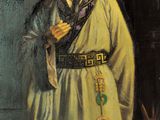Which Legendary Chinese Military Thinker Wrote the Art of War?
The Fine art of War
The Art of War
The Art of War is an influential document about tactical warfare written by the ancient Chinese military strategist Sunzi.
Subjects
Anthropology, Social Studies, Ancient Civilizations, World History, Storytelling
Prototype
Sunzi
Sunzi was a Chinese general and most famously the author of The Art of State of war,one of the first documents on armed forces strategies. Although Sunzi wrote this document thousands of years ago, it continued to influence many world leaders within the past century.
Photograph by Charistoone-Images / Alamy Stock Photo

The Art of War, an influential document written by the ancient Chinese military strategist Sunzi (also known as Dominicus-Tzu), is i of the first known treatise on warfare strategy in history. Known in Chinese as Bingfa, this guide features information about various battle maneuvers and tactics, as well as strategic advice on collecting information virtually the enemy's location and battleground terrain before attacking. It is difficult to know exactly when The Art of War was written, but nigh scholars remember it was written between 475 and 221 B.C.E., during the Warring States catamenia. Scholars also cannot exist certain nigh the details of the life of its writer, Sunzi, merely they believe he was a full general working for the Wu state. It is clear that any Sunzi'due south life experiences were, he had a bang-up deal of noesis about warfare and tactical preparation. The premise of The Art of War is that state of war should be avoided with diplomacy. If it cannot be avoided, information technology should be fought strategically and psychologically to minimize damage and the wasting of resources. Warfare should only be a last resort and heading into battle is already admitting a kind of defeat. Sunzi'due south strategy in dealing with foes was a combination of peaceful resolutions and aggressive warfare. This mirrors the Taoist principals of yin and yang (or opposing simply complementary forces). Sunzi recommended that every leader follow the Tao (or the natural club of the universe) equally a main component of successful leadership. The Art of State of war has many specific battle strategies and advisements. It stresses grooming for battle to a higher place all, including planning effectually climate and battle terrain, studying the enemy's movements and weaknesses, and proper preparation of soldiers. At the same fourth dimension, it also recommends being flexible, because the battlefield is so unpredictable. Information technology discourages generals from engaging in siege warfare, because information technology extends the conflict and wastes resources. And generals should treat captured troops and defeated soldiers respectfully. The Art of War has remained relevant over the years considering it is about strategy and tactics rather than specific warfare technology. It has influenced leaders all over the world, not only in warfare but in many areas of life, including business. Modern leaders such as the one-time chairman of the Chinese Communist party and one of the founders of the People'due south Democracy of China, Mao Zedong, cited The Fine art of War every bit part of their military success.

Sunzi was a Chinese general and near famously the writer of The Art of State of war,i of the outset documents on military machine strategies. Although Sunzi wrote this certificate thousands of years ago, it continued to influence many globe leaders within the by century.
Photo past Charistoone-Images / Alamy Stock Photo
boxing tactic
Substantive
art and science of organizing a military campaign, including troop movement, weaponry, and strategy.
siege
Noun
organized attack on a fortified or protected structure.
strategy
Noun
plan or method of achieving a goal.
Taoism
Noun
Chinese philosophy and religion emphasizing noninterference with the course of natural events.
warfare
Noun
armed conflict between two or more groups of people, usually representing different nations or other political organizations.
yang
Substantive
active, male one-half of yin and hang; represents oestrus, light, and dryness
yin
Noun
passive, female half of yin and yang; represents cold, dark, and wetness
yin and yang
Substantive
inseparable and contradictory elements; a concept found in Taoism
Source: https://www.nationalgeographic.org/encyclopedia/art-war/